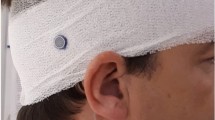Abstract
The goal of this study was to evaluate the MR compatibility of the Neurelec Digisonic SP cochlear implant by performing in vitro and in vivo tests. All tests were performed on 1.5 T machine. Torque and force were measured to observe a potential displacement of the internal receiver. Demagnetisation of the internal magnet was monitored inside the MRI scanner and outside the MRI scanner (in the MRI room). Potential-induced voltage on electrodes was measured in vitro, performing the usual MR sequences. Heating around the internal receiver was measured after the same MR sequences. Following in vitro tests, in vivo MR imaging (brain and posterior fossa MRI) was performed to evaluate the induced signal void and geometrical distortion. In vivo test was performed with one volunteer who had a cochlear implant device fixed to the surface of the skin with a bandage. All the in vitro tests were in compliance with standard EN 45502-2-3 relating to Cochlear Implants. In vivo MRI scans demonstrated an image distortion for spin echo sequences of 7 cm maximum around the internal magnet. Magnetic resonance imaging with the Neurelec Digisonic SP cochlear implant is possible with no measurable adverse effects for either the patient or the device. Image artefact around the internal magnet, however, is unavoidable.




Similar content being viewed by others
References
Hochmair E (2001) MRI safety of Med-El C40/C40+ cochlear implants. Cochlear Implants Int 2:98–114
Youssefzadeh S, Baumgartner W, Dorffner R et al (1998) MR compatibility of Med El cochlear implants: clinical testing at 1.0 T. J Comput Assist Tomogr 22:346–350
Baumgartner W, Youssefzadeh S, Hamzavi J et al (2001) Clinical application of magnetic resonance imaging in 30 cochlear implant patients. Otol Neurotol 22:818–822
Heller JW, Brackmann DE, Tucci DL, et al (1996) Evaluation of MRI compatibility of the modified nucleus multichannel auditory brainstem and cochlear implants. Am J Otol 17:724–729
Teissl C, Kremser C, Hochmair E et al (1998) Cochlear implants: in vitro investigations of electromagnetic interference at MR imaging—compatibility and safety aspects. Radiology 208:700–708
Weber BP, Goldring JE, Santogrossi T et al (1998) Magnetic resonance imaging compatibility testing of the Clarion 1.2 cochlear implant. Am J Otol 19:584–590
Wackym PA, Michel MA, Prost RW et al (2004) Effect of magnetic resonance imaging on internal magnet strength in Med-El Combi40+ cochlear implants. Laryngoscope 114:1355–1361
Gubbels SP, McMenomey SO (2006) Safety study of the Cochlear Nucleus 24 device with internal magnet in the 1.5 Tesla magnetic resonance imaging scanner. Laryngoscope 116:865–871
Acknowledgment
The authors thank B. Friess and O. Le Caharec for their help in this study and P. Jeffrey for editorial assistance.
Author information
Authors and Affiliations
Corresponding author
Rights and permissions
About this article
Cite this article
Vincent, C., Ruzza, I., Vaneecloo, F.M. et al. Magnetic resonance imaging with the Digisonic SP Neurelec cochlear implant. Eur Arch Otorhinolaryngol 265, 1043–1046 (2008). https://doi.org/10.1007/s00405-007-0576-6
Received:
Accepted:
Published:
Issue Date:
DOI: https://doi.org/10.1007/s00405-007-0576-6




